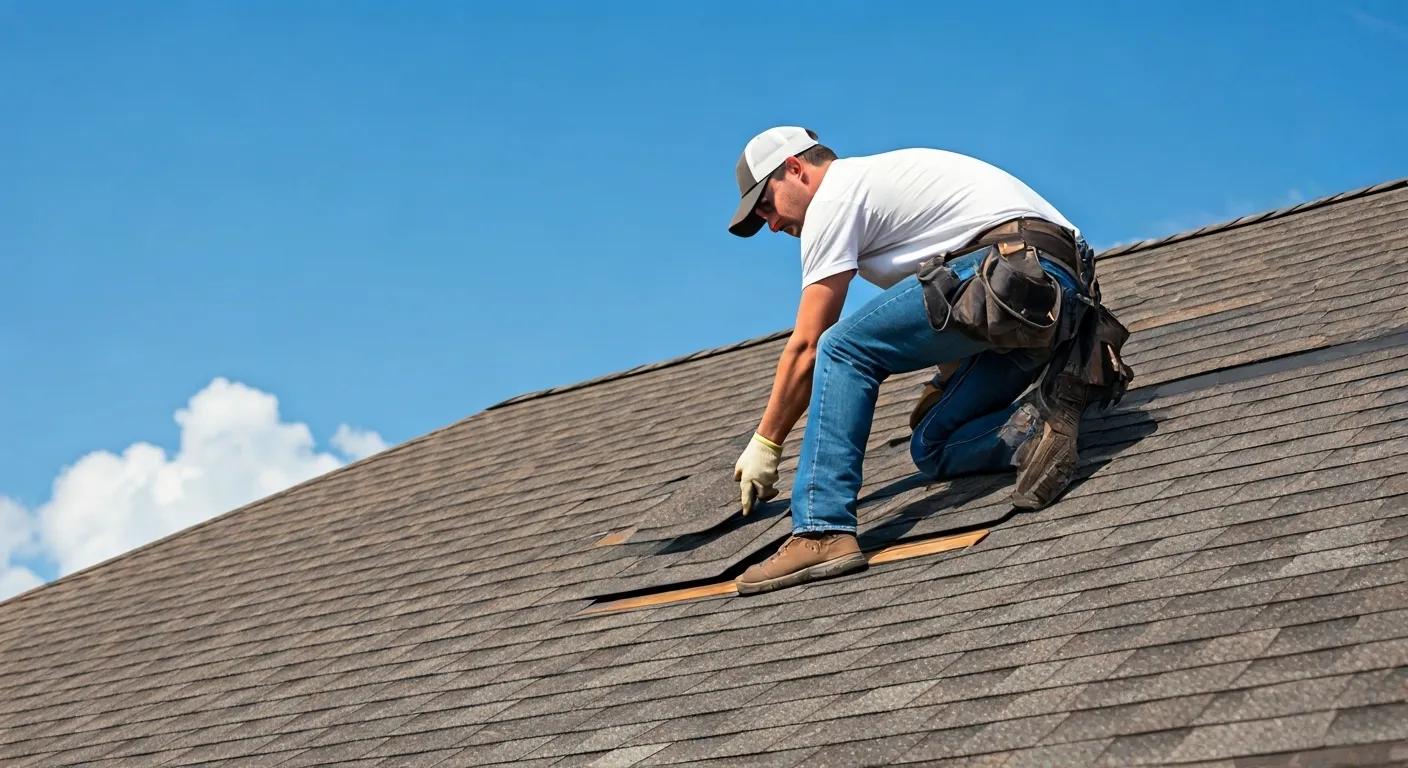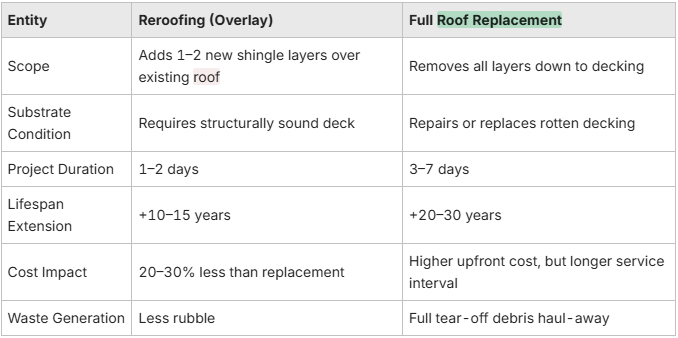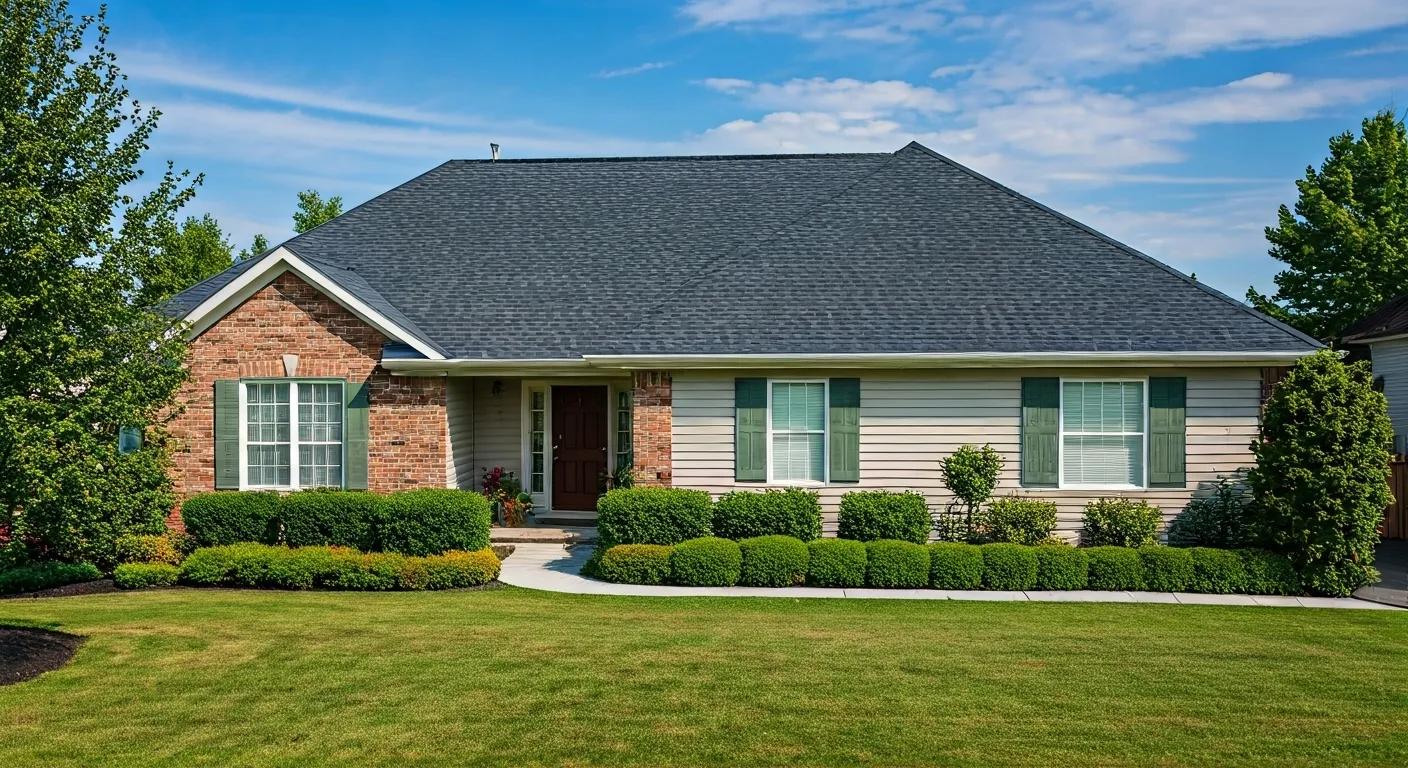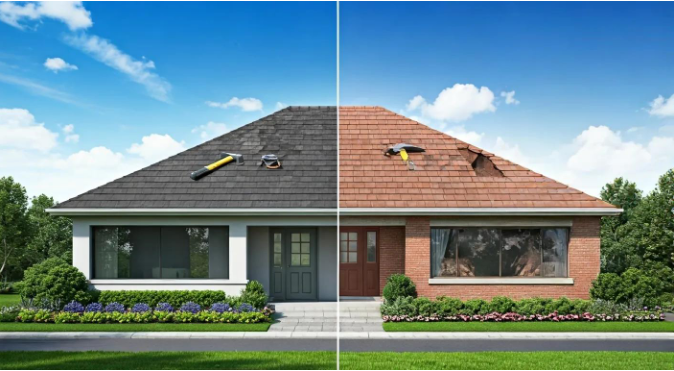Deciding whether to repair your existing roof or invest in a full reroofing project can determine your home’s protection, energy efficiency, and resale value for decades. This comprehensive guide by Adelaide Roofing and Construction explains what roof repair and reroofing entail, when each option makes sense, the pros and cons of both approaches, key decision-making factors like age, damage severity, and budget, a detailed cost comparison, long-term outcomes, emerging industry trends, and answers to common questions. By understanding these elements, you can make an informed choice that maximises durability, curb appeal, and return on investment.
What Is Roof Repair and When Is It the Right Choice?
Roof repair is the targeted remediation of localised damage such as leaks or broken shingles, to restore integrity without replacing the entire covering. It addresses specific issues quickly, prolongs the roof’s usable life, and conserves budget. For relatively young roofs with minor wear or storm damage, timely repairs can prevent escalation into structural problems.
What Does Roof Repair Involve?
Roof repair involves diagnosing the damage source, removing affected materials, replacing or patching shingles, flashing, or underlayment, and sealing to prevent water ingress. Common scenarios include:
- Repairing small leaks around chimneys, vents, or skylights
- Replacing cracked, curling, or missing shingles
- Sealing flashing gaps and ridge cap joints
These targeted actions restore waterproofing and structural stability, preparing the roof for its next service interval while avoiding full replacement.
What Are the Signs You Need Roof Repair?
Before internal damage spreads, watch for these indicators of repair-worthy issues:
- Water stains on ceilings or attic walls
- Missing, cracked, or warped shingles
- Exposed or corroded flashing around roof penetrations
- Granule loss visible in gutters
- Moss or algae growth indicating moisture retention
Early detection and repair stop leaks from undermining roof decking and insulation.
What Are the Advantages of Roof Repair?

Repairs deliver several benefits when used for suitable issues:
- Cost-Effective Restoration: Significantly lower investment than full replacement
- Minimal Disruption: Short project timelines, often completed in hours or a day
- Preservation of Existing Materials: Retains original shingles and underlayment, reducing waste
- Quick Response to Emergencies: Fast leak mitigation prevents interior damage
Roof Repair Cost-Effectiveness
Roof repair is often a more economical choice compared to full replacement, especially for relatively young roofs with minor damage. Timely repairs can prevent minor issues from escalating into more significant structural problems, thereby extending the roof's lifespan and conserving the budget.
What Are the Disadvantages of Roof Repair?
Targeted fixes carry certain limitations:
- Short-Term Lifespan Extension: Repairs may last only a few years before reoccurrence
- Hidden Damage Risks: Underlying rot or mold can be overlooked without full inspection
- Aesthetic Mismatches: New shingles may contrast with weathered surroundings
- Frequent Maintenance: Repeated repairs raise cumulative costs
When repairs become frequent, full reroofing can prove more economical over time.
How Does Roof Repair Extend Your Roof’s Lifespan?
By addressing small breaches before they widen, roof repair halts moisture penetration that causes wood rot, insulation damage, and structural decay. A single leak patch can extend an asphalt shingle roof by 5–10 years, especially when combined with routine inspections, a proactive strategy that maintains weatherproofing and reduces long-term replacement urgency.
What Is Reroofing and Roof Replacement and When Are They Necessary?
Reroofing (overlay) and full roof replacement both involve removing worn materials and installing new roofing assemblies. Reroofing adds a fresh layer over existing shingles when substrate is sound, while replacement includes deck repairs and underlayment renewal. For aged roofs or those with widespread damage, these comprehensive solutions restore full lifespan and performance.
How Do Reroofing and Full Roof Replacement Differ?

What Are the Signs You Need Reroofing or Roof Replacement?
Consider reroofing or replacement if you observe:
- Multiple curling or blistered shingles across large areas
- Significant granule loss exposing asphalt mat
- Sagging roof deck indicating structural fatigue
- Roof age exceeding manufacturer lifespan (20–25 years for asphalt)
- Recurring leaks at multiple points despite repairs
Extensive wear or aging justifies comprehensive reroofing or full replacement.
What Are the Advantages of Reroofing and Roof Replacement?

Comprehensive roof renewal brings these benefits:
- Long-Term Solution: New warranties and extended lifespans up to 30 years
- Improved Energy Efficiency: Better underlayment and reflective shingles lower cooling costs
- Enhanced Home Value: A new roof boosts curb appeal and resale appraisal
- Structural Inspection: Full replacement uncovers hidden deck issues for complete remediation
A renewed roof safeguards against future leaks and elevates property performance and equity.
What Are the Disadvantages of Reroofing and Roof Replacement?
Full-scale projects require trade-offs:
- Higher Initial Investment: Replacement can cost 3–4 times a major repair
- Longer Disruption: Removal, decking repairs, and installation span days to a week
- Increased Waste: Tear-off generates significant debris requiring disposal
- Potential Permitting: Local regulations may limit overlay thickness or require tear-off
Despite these barriers, the longevity and peace of mind often justify the upfront commitment.
How Does a New Roof Improve Your Home’s Value and Energy Efficiency?
A professionally installed roof enhances energy efficiency by integrating modern reflective shingles, improved insulation, and air-sealed flashing, which reduce heat gain by up to 20%. Real estate appraisers typically add 60–70% of roof replacement cost to home value, making it a strategic investment that combines aesthetics, comfort, and financial return.
Home Value and Energy Efficiency
A professionally installed roof can significantly enhance a home's energy efficiency by incorporating modern reflective shingles, improved insulation, and air-sealed flashing. These improvements can reduce heat gain, contributing to lower cooling costs and increasing the home's overall value.
How to Decide Between Roof Repair and Roof Replacement?
Deciding hinges on five key factors like roof age, damage type and extent, budget, future home plans, and local climate. Weighing each criterion against your goals clarifies whether a targeted repair or complete reroofing aligns with long-term performance and cost objectives.
How Does Roof Age Affect Your Roofing Decision?
- Under 10 years: Repairs safely extend use for isolated problems
- 10–20 years: Frequent repairs suggest nearing replacement threshold
- Over 20 years: Replacement often offers better value and warranty coverage
Considering lifespan benchmarks prevents investing in repairs that outlast the roof’s natural durability.
How Does the Type and Extent of Roof Damage Influence Your Choice?

Targeted issues under moderate severity suit repairs, but pervasive wear demands full-scale renewal.
What Role Does Budget Play in Repair vs Replacement?
Budget planning should factor immediate cost and lifecycle expenses:
- Short-Term Budget: Choose repair for urgent, minor leaks
- Mid-Term Outlook: Compare cumulative repair costs against replacement amortised over remaining years
- Financing Options: Evaluate roofing loans or payment plans for replacement to preserve cash flow
Prudent budgeting aligns spending with projected benefits and reduces unexpected capital needs.
How Do Future Home Plans Impact Your Roofing Decision?
- Planning to sell in next 1–3 years: A full replacement maximises curb appeal and buyer confidence
- Staying long-term: Reroofing ensures decades of protection, supporting home equity growth
- Budget-sensitive renovation: Repairs maintain performance until major overhauls align with other upgrades
Align roofing investment with your property timeline to optimise return on expenditure.
How Do Climate and Roofing Materials Affect Your Choice?
- Coastal salt air: Metal roofing resists corrosion but may require replacement over extended periods
- Hot summers: Cool-roof shingles or tile reflect solar heat, prolonging roof lifespan
- Storm-prone zones: Impact-resistant shingles reduce frequent repair needs
Selecting climate-suitable materials and timing reroofing before peak weather events prevents accelerated wear and costly reactive fixes.
What Are the Cost Differences Between Roof Repair and Roof Replacement?
Comparing roof repair and replacement costs in Adelaide reveals significant divergence driven by scope, materials, and labor. Repair typically ranges from a few hundred to a few thousand dollars, while replacement often starts at several thousand and can escalate based on size and shingle type.
What Is the Average Cost of Roof Repair in Adelaide?
Average roof repair costs in Adelaide span AU$200 to AU$2,500, depending on the issue:
- Minor shingle replacement: AU$200–500
- Flashing and leak sealing: AU$500–1,200
- Structural deck patching: AU$1,200–2,500
What Is the Average Cost of Roof Replacement in Adelaide?
A full asphalt shingle replacement in Adelaide typically ranges from AU$8,000 to AU$15,000 for a 200 sqm roof, influenced by:
- Shingle quality and warranty level
- Roof complexity and slope
- Underlayment upgrades and insulation enhancements
- Tear-off and disposal fees
How Does Return on Investment Compare for Repair vs Replacement?
While repairs offer immediate cost relief, replacement yields higher long-term ROI:
- Repair ROI: Extends roof life by 5–10 years at low cost, ROI of 150–200% when preventing interior damage
- Replacement ROI: Adds 60–70% of cost to home value, energy savings recoup up to 10% of total through cooling reductions
How Do Roofing Materials Affect Repair and Replacement Costs?

What Does a Cost Comparison Table Reveal About Repair vs Replacement?

What Are the Long-Term Benefits and Drawbacks of Roof Repair and Replacement?
Assessing outcomes over decades clarifies strategic value. Repairs preserve capital now but may drive recurring maintenance, while replacements require higher investment for sustained performance.
How Durable Are Roof Repairs Compared to Replacements?
Repairs restore short-term integrity yet often need follow-up service within 3–7 years. In contrast, a full replacement with quality materials lasts 20–30 years with minimal upkeep, reducing lifecycle expenditures and limiting exposure to weather-related damage.
How Does Each Option Affect Home Value and Curb Appeal?
Targeted repairs patch visible issues but may leave color and texture disparities that impact aesthetic cohesion. A uniform new roof elevates visual appeal, signals overall home health to buyers, and typically appends significant resale value, justifying replacement for market-driven goals.
What Energy Efficiency Improvements Can You Expect?
A repair does not improve thermal performance beyond original design. Replacement allows selection of high-reflectance shingles, added insulation, and radiant barriers, which can lower cooling loads by up to 20%, a benefit that accumulates over the roof’s service life.
How Much Disruption and Time Commitment Does Each Option Require?
Repairs often finish in a day with minimal site disturbance. Reroofing or replacement occupies the property for 3–7 days, involving noise, foot traffic, and debris. Planning around these windows ensures homeowner preparedness and smooth project completion.
What Are the Latest Industry Trends and Technologies in Roofing?
Advances in materials and methods shape the future of roof repair and replacement, offering homeowners smarter, greener, and more resilient options.
How Are Smart Roofing Technologies Changing Roof Repair and Replacement?
Internet of Things (IoT) sensors embedded in shingles transmit real-time moisture and temperature data, enabling predictive maintenance that addresses damage before leaks occur. Drone-based roof inspections capture high-resolution imagery for accurate condition assessments, reducing human risk and expediting diagnostics.
What Sustainable and Energy-Efficient Roofing Options Are Available?
- Cool Roof Coatings: Reflective paints that lower surface temperatures by 10–15 °C
- Green Roof Systems: Vegetated assemblies that improve insulation and stormwater management
- Recycled Materials: Shingles made from reclaimed rubber or plastics offering comparable durability
How Does Extreme Weather Impact Roofing Decisions in Adelaide?
Adelaide’s hot summers, occasional hail, and coastal winds demand robust material selection. Impact-rated shingles resist hail punch-through, while corrosion-resistant metal alloys withstand salty breezes. Choosing climate-tested products minimises reactive repairs after severe events.
What Are the Current Market Statistics for Roofing Services?
Roofing remains a growing sector in Australia, with industry revenue projected to rise by 4.2% annually through 2026. Approximately 40% of residential roofing projects focus on replacement, while 60% involve repairs and maintenance highlighting homeowners’ ongoing demand for both immediate fixes and long-term renewals.
Frequently Asked Questions About Reroofing vs Roof Repair
Is It Cheaper to Repair or Replace a Roof?
Repair is cheaper upfront typically 10–20% of replacement cost for isolated issues, but replacement delivers greater longevity and ROI over the roof’s full service life.
When Should You Repair a Roof Instead of Replacing It?
Repair is ideal when damage is limited to a few shingles or small leaks on a roof less than 10 years old, preserving budget while extending usable life.
What Is the Difference Between Reroofing and Roof Repair?
Repair fixes specific defects, whereas reroofing overlays new materials atop existing ones. Reroofing addresses overall wear but not underlying deck issues repaired only by full replacement.
How Do I Know If I Need Reroofing or Roof Repair?
Inspect for widespread shingle curling, granule loss, sagging decking, and roof age over 20 years. If multiple areas show distress, a reroof or replacement is warranted.
Can Roof Repair Delay the Need for Replacement?
Yes, timely repairs can postpone full replacement by stabilising problem spots and preventing moisture-induced decay, allowing you to schedule reroofing when it best fits long-term planning and budget cycles.
A thorough understanding of roof repair and reroofing empowers Adelaide homeowners to protect their investment, optimise energy performance, and enhance curb appeal. For expert guidance, inspections, and customised roofing solutions, connect with Adelaide Roofing and Construction to evaluate your property’s needs and determine the most cost-effective, durable path forward.

